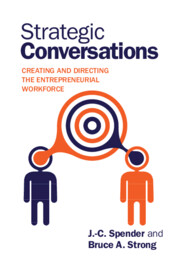Book contents
- Frontmatter
- Contents
- List of figures
- List of tables
- Acknowledgements
- Preface
- 1 Introduction – what are strategic conversations?
- 2 The strategic conversations imperative
- 3 Strategic conversations in the wild
- 4 Engaging employees in management’s agenda
- 5 Strategizing and the leaders’ role
- 6 Putting strategic conversations into practice – innovation communities
- 7 Conversation trumps structure – new norms for dialog
- 8 Strategic conversations across geographies, generations, and the multitude
- 9 Engaging the world outside in the conversation
- 10 Creating a self-reinforcing innovation platform – collateral benefits
- 11 Measuring the future
- 12 Epilogue – on managing
- Further reading
- Notes
- Index
7 - Conversation trumps structure – new norms for dialog
Published online by Cambridge University Press: 05 June 2014
- Frontmatter
- Contents
- List of figures
- List of tables
- Acknowledgements
- Preface
- 1 Introduction – what are strategic conversations?
- 2 The strategic conversations imperative
- 3 Strategic conversations in the wild
- 4 Engaging employees in management’s agenda
- 5 Strategizing and the leaders’ role
- 6 Putting strategic conversations into practice – innovation communities
- 7 Conversation trumps structure – new norms for dialog
- 8 Strategic conversations across geographies, generations, and the multitude
- 9 Engaging the world outside in the conversation
- 10 Creating a self-reinforcing innovation platform – collateral benefits
- 11 Measuring the future
- 12 Epilogue – on managing
- Further reading
- Notes
- Index
Summary
Argument based on knowledge implies instruction, and there are people whom one cannot instruct. Here, then, we must use, as our modes of persuasion and argument, notions possessed by everybody.
Aristotle, RhetoricWhen managers are looking to reinvigorate a company, often their first thought is to reshuffle the organizational structure. But this puts the cart before the horse. Conversation trumps structure. A company having meaningful strategic conversations can thrive even when the org chart isn’t quite right; the best organigram won’t save a company with poor conversational health. Conversation may be a soft topic but it is about hard truths. At the end of the day, not having honest dialog is as serious as running out of cash. All the elements essential for good strategizing – from understanding customers to engaging employees to developing leaders to sparking innovation – depend on it.
At the most basic level, leadership needs to convince employees to participate, to join the energized circle of innovators from which many feel excluded as they talk about the leadership as ‘them.’ At a large financial firm for which we’ve done work, information technology employees we surveyed didn’t believe it was their job to innovate the business model and couldn’t name any innovations that had come from their group. But in fact the group was actively involved in profoundly changing the organization’s business model. By using advanced algorithms, they were automating trading in several asset classes, radically reducing transaction costs and creating new hedging opportunities for customers. By explaining what innovation was, and by illustrating areas in which the group had already made a contribution, we helped convince these employees to be more engaged in the strategizing process.
- Type
- Chapter
- Information
- Strategic ConversationsCreating and Directing the Entrepreneurial Workforce, pp. 126 - 147Publisher: Cambridge University PressPrint publication year: 2014

